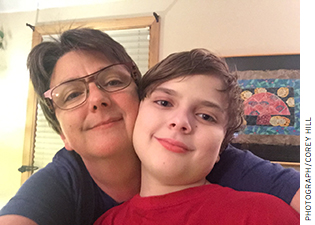It was at the fourth meeting about my son’s issues with pencils that I felt something snap in my soul. I was sitting with no fewer than six well-paid professionals in a windowless room at his school, along with my boy’s father and his special-education case manager. Adding up the wages we would all be paid in an hour, how many thousands of dollars had we spent discussing something that maybe cost a dime?

Corey has Asperger’s syndrome. Pencils challenge him for two reasons: He can’t tolerate the scratching noise they make on the paper. And his brain has a wrinkle called a processing speed lag; oversimplified, that means he thinks too fast for his hands to keep up. By the time the pencil’s in motion, he’s on to another thought.
Once, in 3rd grade, he flung his pencil across the classroom. The school social worker demanded I come get him—and have him evaluated for a behavioral disorder.
Math was the subject that set off the marathon of meetings with school specialists in 7th grade. Corey is very good at math, but it had become a tug of war. I pushed for him to be able to do his work using a keyboard, but his math teacher was holding out, insisting he use worksheets and show his work, in pencil.
The discussions were mind-numbing. We couldn’t get him an iPad, because that would be a shiny object no one else had. A Chromebook wouldn’t inspire envy, but where would it be kept? Should the school label it with his name, or would that imply it was his to keep?
As the questions persisted, my annoyance gave way to a much more fundamental concern. In Minneapolis, where I live, one in five students has a special education plan. Almost one-fourth of the students are learning English for the first time. Teachers struggle to reach every child, both those who enter their classrooms years behind and high achievers who need continual challenges. It’s a tall order.
This particular well-regarded middle school had rooms full of Apple computers that students mostly used to check their online grade trackers. And because math teachers are in perennially short supply, the school offered just one section of higher-level math. Kids had to earn their way into that class, and Corey, needing a different way to show his aptitude, would never manage it.
I asked myself: Why can’t we use the computers to differentiate instruction and also provide enrichment for students who need it? With too few excellent math instructors, why can’t we use technology to help close the teacher talent gap? The pencil wasn’t the problem, nor was Corey. The problem was the persistent belief that school must happen in a particular way: within four walls, with a single teacher presiding in front of the class.
Fast-forward a year to a very different special-ed planning meeting. Corey was finishing 8th grade at an innovative charter school where teachers coach students in creating individual road maps for meeting state academic standards. Technology, and creativity in using it, abound at Venture Academy. Students do math online, and Corey can use quizzes to puzzle through it.
Disagreements over Corey’s math instruction didn’t disappear this past year, but they were meaningful and productive. Instead of stubbornly battling over worksheets, my boy and his teacher interacted about his ability to regulate his anxiety when an equation or concept got hard. He’s learning to persist, discovering how good mastery feels, and—the brass ring for a young person with disabilities—figuring out how to advocate for himself.
Given the autonomy to tap into subjects in a way that ignites their passion, the kids at Corey’s school are soaring. Ninety-two percent qualify for free or reduced-price lunch, yet Venture’s students made bigger fall-to-spring gains than all but one of the city’s schools. And that one school has had its students since kindergarten.
Corey’s teachers spent last summer literally building the high school he’s now attending. There are conventional classrooms, but also breakout rooms where small groups can collaborate, a commons, and a quiet room for the many students who, like Corey, have sensory issues. Soon he’ll have internships two days a week and an occupational therapist to help him learn to manage new environments.
It’s a brave and hopeful thing. There will be joy and struggle and growth. And a few pencils, I imagine.
Based in Minneapolis, Beth Hawkins is an award-winning writer who covers K–12 education. She is the writer-in-residence at Education Post.
This article appeared in the Winter 2017 issue of Education Next. Suggested citation format:
Hawkins, B. (2017). The Problem with Pencils: Using computers—and creativity—to customize instruction. Education Next, 17(1), 86.


